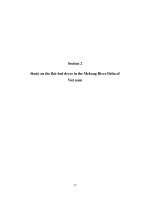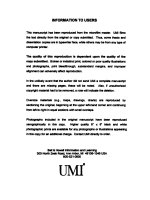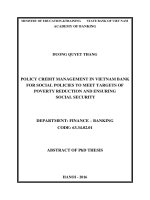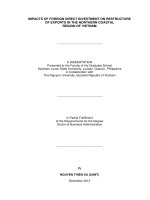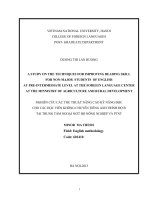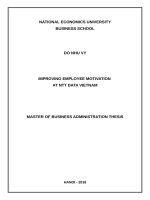EMPLOYEE MOTIVATION AT THE INFORMATION TECHNOLOGY CENTER OF VIET NAM BANK FOR SOCIAL POLICIES
Bạn đang xem bản rút gọn của tài liệu. Xem và tải ngay bản đầy đủ của tài liệu tại đây (1.24 MB, 85 trang )
E
MBA17
A
NATIONAL ECONOMICS UNIVERSITY
NEU BUSINESS SCHOOL
---o0o---
NGUYE
N VIET
BAC
NGUYEN VIET BAC
HANOI
- 2020
EMPLOYEE MOTIVATION AT
THE INFORMATION TECHNOLOGY CENTER OF
VIET NAM BANK FOR SOCIAL POLICIES
MASTER OF BUSINESS ADMINISTRATION THESIS
HANOI – 2020
NATIONAL ECONOMICS UNIVERSITY
NEU BUSINESS SCHOOL
---o0o---
NGUYEN VIET BAC
EMPLOYEE MOTIVATION AT
THE INFORMATION TECHNOLOGY CENTER OF
VIET NAM BANK FOR SOCIAL POLICIES
MASTER OF BUSINESS ADMINISTRATION THESIS
SUPERVISOR: PH.D. TRAN THI MINH HUONG
HANOI – 2020
ACKNOWLEGMENT
First and foremost, I am deeply grateful to the Business School, National
Economics University (BSNEU) with all the members, lecturers and assistants for
the knowledge and experience that has been shared through many lectures,
discussions and exams during EMBA program.
Next, I would like to express my sincere gratitude to my supervisor, Ph. D
Tran Thi Minh Huong for your patience, motivation, enthusiasm, and immense
knowledge, guidance helped me in all the time of research and writing of this
thesis.
I would like to sincerely thank the Board of Directors and co-workers at
Information Technology Center – The Viet Nam bank for social policies for their
supporting in collecting information as well as data related to the research topic and
create the best conditions for me to complete this graduation thesis.
Last but not the least, I also thanks to my family, without their
encouragement, support and understanding, it would be impossible for me to finish
this work.
Although I have made many efforts to complete the thesis with all my
enthusiasm and abilities, but can not avoid the, imperfections, I look forward to
receiving valuable contributions from supervisor, teachers, lectures of BSNEU and
all member of ITC-VBSP.
Hanoi, October 2020
Viet Bac Nguyen
TABLE OF CONTENTS
ACKNOWLEGMENT
ABBREVIATIONS
LIST OF FIGURES
LIST OF TABLES
EXECUTIVE SUMMARY------------------------------------------------------------------- 1
CHAPTER 1: INTRODUCTION-----------------------------------------------------------3
1.1. Rationale------------------------------------------------------------------------------------ 3
1.2. Research objectives------------------------------------------------------------------------ 4
1.3. Research questions------------------------------------------------------------------------- 5
1.4. Research methodology--------------------------------------------------------------------- 5
1.4.1. Research process--------------------------------------------------------------------5
1.4.2. Data collection method-------------------------------------------------------------5
1.4.3. Data analysis------------------------------------------------------------------------- 6
1.5. Research Scope----------------------------------------------------------------------------- 6
1.6. Research Structure-------------------------------------------------------------------------6
CHAPTER
2:
THEORETICAL
BACKGROUND
OF
EMPLOYEE
MOTIVATION IN THE ORGANIZATIONS---------------------------------------------8
2.1. Definitions on motivation and employee motivation----------------------------------8
2.1.1. Definitions of motivation-----------------------------------------------------------8
2.1.2. Employee motivation definition---------------------------------------------------8
2.2. Motivation theories------------------------------------------------------------------------- 9
2.2.1. Maslow’s Hierarchy of Needs-----------------------------------------------------9
2.2.2. Victor Vroom’s Expectancy Theory----------------------------------------------11
2.2.3. The Two-Factor Theory (Herzberg)---------------------------------------------15
2.3. Proposed research model applied in the thesis----------------------------------------16
CHAPTER
3:
ANALYSIS
OF
THE
CURRENT
EMPLOYEE
MOTIVATION------------------------------------------------------------------------------- 21
3.1. Overview of ITC and Viet Nam Bank for social policies.---------------------------21
3.1.1. Foundation and development of Information Technology Center and VBSP-----21
3.1.2. Organizational structure of Information Technology Center.-----------------26
3.1.3. Performance result in 2019-------------------------------------------------------27
3.1.4. Human resources at Information Technology Center.-------------------------29
3.2. Data analysis------------------------------------------------------------------------------- 34
3.2.1. Reliability of measurement scales (Cronbach’s Alpha)-----------------------34
3.2.2. Exploratory Factor Analysis------------------------------------------------------37
3.2.3. Regression Analysis and Hypothesis Testing-----------------------------------40
3.3. Analyzing employee motivation based on Herzberg theory at Information
Technology Center----------------------------------------------------------------------------- 44
3.3.1. Pay----------------------------------------------------------------------------------- 44
3.3.2. Recognition------------------------------------------------------------------------- 45
3.3.3. Relation with others---------------------------------------------------------------46
3.3.4. Responsibility---------------------------------------------------------------------- 47
3.4. Assessment on employee motivation of Information Technology Center----------48
3.4.1. Achievements----------------------------------------------------------------------- 48
3.4.2. Shortcomings----------------------------------------------------------------------- 49
3.4.3. Causes of shortcomings-----------------------------------------------------------50
CHAPTER 4: SOLUTIONS TO IMPROVE EMPLOYEE MOTIVATION AT
INFORMATION TECHNOLOGY CENTER-------------------------------------------52
4.1. Business orientation and executive resolution agenda for 2020 and up to 2025-----------52
4.2. Solutions to improve employee motivation in Information Technology Center-----------56
CONCLUSION------------------------------------------------------------------------------- 59
REFERENCES
APPENDIX
Appendix 1. EMPLOYEES MOTIVATION QUESTIONAIRE
Appendix 2: INTERVIEW QUESTION FOR MANAGER
Appendix 3: SURVEY RESULTS
ABBREVIATIONS
BOD
HRM
HO
IT
ITC
SMS
SPSS
VBSP
Board of Directors
Human Resource Management
Head Office
Information Technology
Information Technology Center
Short Message Service
Statistical Product and Services Solutions
Viet Nam Bank for Social Policies
LIST OF FIGURES
Figure 1.1 Research process.---------------------------------------------------------------- 6
Figure 2.1. Maslow’s Hierarchy of needs------------------------------------------------11
Figure 2.2. Victor Vroom’s Expectancy Theory-----------------------------------------12
Figure 2.3. Two-Factor Theory------------------------------------------------------------17
Figure 2.4. Model applied in the thesis---------------------------------------------------18
Figure 3.1. The Organization Structure of VBSP---------------------------------------27
Figure 3.2. The Organization structure of Information Technology Center----------30
Figure 3.3. Gender of employees---------------------------------------------------------33
Figure 3.4. Year of working of employees-----------------------------------------------33
Figure 3.5. Educational qualification of employees------------------------------------34
LIST OF TABLES
Table 2.1. Employees motivation dimention--------------------------------------------21
Table 3.1: Cronbach’s alpha summary---------------------------------------------------38
Table 3.2: Cronbach’s alpha summary after removed RO3 (Relation with others)- 39
Table 3.3: Cronbach’s alpha summary after removed QS1 (Quality of supervision)------39
Table 3.4. Reliability test of factor “Employee Motivation”---------------------------39
Table 3.5. KMO and Bartlett's Test-------------------------------------------------------40
Table 3.6. Total variance explained-------------------------------------------------------40
Table 3.7: Rotated Component Matrix---------------------------------------------------41
Table 3.8: KMO and Bartlett's Test for Dependent variable---------------------------43
Table 3.9. Model Summary----------------------------------------------------------------43
Table 3.10. ANOVA------------------------------------------------------------------------44
Table 3.11. Coefficients--------------------------------------------------------------------44
Table 3.12. Model Summary--------------------------------------------------------------45
Table 3.13. ANOVA------------------------------------------------------------------------45
Table 3.14. Coefficient Correlations------------------------------------------------------46
Table 3.15. Coefficients--------------------------------------------------------------------46
Table 3.16. Assessment towards Pay factor----------------------------------------------47
Table 3.17. The respondents towards Pay factor----------------------------------------48
Table 3.18. Assessment towards Recognition factor------------------------------------49
Table 3.19. Assessment towards Relation with others factor--------------------------50
Table 3.20. Assessment towards Responsibility factor---------------------------------50
Table 3.21. Assessment towards Employee motivation factor-------------------------51
EXECUTIVE SUMMARY
Today, in the process of innovation and development, human resources are
recognized as the most important factor, decisive factor to success, failure, prestige,
status, ability to develop sustainably of the organization. Therefore, all countries
place people at the center of development and formulate policies and strategies for
human development to serve the needs of the present and the future.
The Viet Nam Bank for social policies (VBSP) has officially started its
operations since March 11th, 2003, based upon the, re-organization of the Vietnam
Bank for the Poor and separation, from Vietnam Bank for, Agriculture & Rural
Development (VBARD) for the, purpose of separating the preferential credit from
the commercial credit in commercial banks. VBSP acts as a non-profit credit
institution with a compulsory reserve ratio of 0% and its solvency is, guaranteed by
the Government. It is, exempted, from deposit insurance, taxes. VBSP is a Stateowned credit, institution that is currently in charge of providing policy credit to the
poor and, other policy beneficiaries. VBSP implements such basic operations of a
bank as: capital mobilization (from international and domestic individuals and
organizations; receiving capitals from the, government and People’s Committee,
etc.); extending loans to the poor and other policy beneficiaries and payment
services.
Implementing the information technology development strategy plan in
VBSP's Strategic Development Plan for the, period of 2011-2020, applying modern
technology as per the operation of VBSP to improve labor productivity, increase the
efficiency of professional handling in the, VBSP. ITC has successfully implemented
the Upgrading and Informatics modernization project and continues to invest in
many IT infrastructure, projects to develop, software and apply more deeply
information technology into business activities towards a professional and modern
VBSP.
In the context of limited resources (financial and human), ITC is determined
1
to play a key strategic role in the next stage of VBSP. What is required to do ITC's
operation to achieve the highest efficiency. How to improve employee motivation at
ITC. Therefore, the author would like to choose the topic “Employee motivation at
the Information technology center of Viet Nam bank for social policies”.
The objectives of the research are to: (1) Find and choose the most suitable
the theoretical background related to employee motivation; (2) Analyze the current
employee motivation at the Information technology center of VBSP. Assess the
strengths and weaknesses of employee motivation at this center; (3) Propose
recommendations to enhance employee motivation at the Information technology
center of VBSP.
The researcher used secondary data and primary data to implement the research.
Primary data were collected by indepth interviews with 3 managers of ITC-VBSP and
survey (70 employees who was working in ITC-VBSP). The reseacher used qualitative
method to analyze secondary data collected. For primary data, the researcher used
quantitative method over some statistical techniques consist of: Cronbach’s Alpha,
EFA, regression analysis and descriptive analysis by means and standard diviation.
The survey results show that Pay has the strongest impact on employee
motivation at ITC, then Recognition, Relation with other and Responsibility
repectively. The ITC has some achievements in employee emotioning, such as
Salary temporarily ensures the living standard for employees to help them feel
secure in their work; The result performance of the tasks are assessed at the end of
the month; have very close relationship within their department…
The researcher also gave out some solution to improve employee motivation
at ITC such as enhancing and supplementing the salary payment mechanism;
Focusing to assign responsibility to Employees which are allowed to do jobs that
are suitable for their forte ability; Renovate the rewarding work through periodic
increase in commendation every month or quarter so that the reward is timely…
Due to limited time and knowledge, the researcher still can not takes a
deeper analyze of employee motivation at ITC-VBSP. However, the thesis can be
2
used as a reference and base for more intensive study on employee motivation in
particular in branch or district transaction offficer in VBSP system.
CHAPTER 1
INTRODUCTION
1.
Rationale
Managing human resource plays a crucial role in the process of
organization’s effectiveness. One of the most, important functions of HRM is,
motivation. However, because of complex nature of human behavior, motivation is
not easy to understand and use. It is represented by author, such as Maslow,
McClelland and Herzberg. While some motivation theories try to find out how
motivation occurs. Vroom, Adams, Locke and, Lantham created the most influential
process.
Recognizing the importance of motivation for work, management
organizations are making great efforts to better understand and understand the
phenomena that form, the basis of man’s need to create, to develop, to progress. The
level of motivation of employees is actually a topic that both theoreticians and
practitioners approach with increasing interest, since the motivation of employees
occupies a significant place in the research of organizational behavior. Today, the
focus of the researcher focuses on intrinsic criteria for job satisfaction, where, apart
from the personality trait, attention is focused on examining the impact of the
organization and family, balance on the motivation of the employee, or in general to
his satisfaction with the quality of life. Modern motivation theories indicate that the
motivation that employees feel about their work is less related to material rewards
and more to the job design, itself. As a result, initiatives for expansion, ie
“enrichment of work”, have been used as key terms: empowerment, creativity and
innovation, flexibility, autonomy, intrinsic motivation, team work...Motivation of
employees represents the level of energy, dedication and creativity that the
employees of the organization bring to their jobs. Motivated employees help
organizations to survive and advance, they are more, dynamic and productive, but
3
realizing the importance of employee motivation raises the question of how to
enable it in the context of modern fast-changing jobs. The starting point of each,
manager is to see and understand what motivates employees in the context of the
roles they perform, because of all the functions that the manager does, motivation of
employees is certainly the, most complex, given the fact that what motivates
employees is constantly changing.
The Viet Nam Bank for social policies (VBSP) has officially started its
operations since March 11th, 2003, based upon the re-organization of the Vietnam
Bank for the Poor and separation from Vietnam Bank for Agriculture & Rural
Development (VBARD) for the purpose of separating the preferential credit from
the commercial credit in commercial banks. VBSP acts as a non-profit credit
institution with a compulsory reserve ratio of 0% and its solvency is guaranteed by
the Government. It is exempted from deposit insurance, taxes. VBSP is a Stateowned credit institution that is currently in charge of providing policy credit to the
poor and other policy beneficiaries. VBSP implements such basic operations of a
bank as: capital mobilization (from international and domestic individuals and
organizations; receiving capitals from the government and People’s Committee,
etc.); extending loans to the poor and other policy beneficiaries and payment
services.
Implementing the information technology development strategy plan in
VBSP's Strategic Development Plan for the period of 2011-2020, applying modern
technology as per the operation of VBSP to improve labor productivity, increase the
efficiency of professional handling in the VBSP. ITC has successfully implemented
the Upgrading and Informatics modernization project and continues to invest in
many IT infrastructure projects to develop software and apply more deeply
information technology into business activities towards a professional and modern
VBSP.
In the context of limited resources (financial and human), ITC is determined
to play a key strategic role in the next stage of VBSP. What is required to do ITC's
operation to achieve the highest efficiency. How to improve employee motivation.
4
Therefore, the author would like to choose the topic “Employee motivation at the
Information technology center of Viet Nam bank for social policies”.
2.
Research objectives
Synthesize the theoretical background related to employee motivation;
Analyze the current employee motivation at the Information technology
center of VBSP. Assess the strengths and weaknesses of employee motivation at this
center.
Propose recommendations to enhance employee motivation at the
Information technology center of VBSP.
3.
Research questions
What are the factors affecting employee motivation?
What are the current employee motivation of VBSP's ITC? What are
strengths, weaknesses, and their root causes?
What should VBSP's ITC do to improve its employee motivation?
4.
Research methodology
5.
Research process
The research conducted via 5 steps below:
5
Figure 1.1 Research process
6.
Data collection method
Secondary Data
Secondary data were collected from the previous studies, textbooks,
published documents, research papers, articles on specialized journals, etc. Internal
reports and documents of ITC from 2017 – 2019.
Primary Data
Primary data were collected via in-depth interviews and survey
questionnaires.
An In-depth interview conducted with the Director and 3 Vice directors at
VBSP’s ITC. The contents of the interview mentioned the current employee
motivation of ITC-VBSP, assessing the employee motivation and solutions to
improve staff motivation at ITC.
Online survey questionnaires were sent to the whole of ITC’s employees (70
peoples). The number of respondents to the survey is 70. All survey forms collected
6
are valid.
Questions revolved around the factors that affect the motivation of
employees according to the theory applied in the thesis.
This study used a Likert scale five-level. The first level is Strongly Disagree
and the fifth level is Strongly Agree.
7.
Data analysis
The researcher conducted regression data analysis. Secondary data
summarized by textual writing-up in tables. Primary data collected from in-depth
interview and survey captured and analysed by SPSS (Statistical Package for the
Social Sciences).
8.
Research Scope
Research object: This thesis focuses employee motivation at the Information
technology center of VBSP
Location Scope: Research conducted at VBSP’s ITC.
Time:
+ Secondary data: from 2017 to 2019
+ Primary data: 2020
9. Research Structure
Apart from the acknowledgement, table of contents, executive summary,
conclusion, reference and appendixes, the study included 4 chapters:
Chapter 1: Introduction
7
Chapter 2: Theoretical background of employee motivation in the
organization.
Chapter 3: Analysis of employee motivation at the Information
Technology Center.
Chapter 4: Solutions to improve employee motivation at Information
Technology Center.
8
CHAPTER 2: THEORETICAL BACKGROUND OF
EMPLOYEE MOTIVATION IN THE ORGANIZATIONS
11. Definitions on motivation and employee motivation
12. Definitions of motivation
The term motivation is derived from the Latin word “movere” which means
“to move”. The definition, of motivation in Cambridge, dictionary is: “enthusiasm
for doing something”. An extended definition of motivation encompasses the idea
of promoting individual’s willingness to invest more efforts to achieve specific
objective: Steers, R. (1984) define, motivation as “that which, energizes, directs,
and sustains human behavior”.
Conroy (1994) has defined motivation as “a person’s active participation in
and commitment to achieving the prescribed results.”
Bartol and Martin (1998) define motivation as “a force, that energizes
behavior, gives direction to behavior, and underlies the tendency to persist”.
Stephen P. Robbins and Mary K. Coulter (2011): “motivation refers to the
process by which a person’s efforts are energized, directed, and sustained toward
attaining a goal”.
In summary, this work will use the definition by Steers, R. (1984):
Motivation is defined as that which energizes, directs, and sustains human behavior.
This definition has three key elements: energy, direction, and persistence.
13.
Employee motivation definition
R. Kanfer (1990) define employee motivation as the psychological forces
within a person that determine the direction of that person’s behavior in an
organization, effort level, and persistence in the face of obstacles.
The three key elements of Employee motivation:
- Direction of behavior: Direction of behavior refers to the behavior
employees choose to perform from the many potential behaviors they could
9
perform.
- Level of efforts: How hard does a person work to, perform a chosen
behavior? It is not enough for an organization to motivate employees to perform
desired functional behaviors; the organization must also motivate them to work hard
at these behaviors.
- Levels of persistence: When faced with obstacles, roadblocks, and stone
walls, how hard does a person keep trying to perform a chosen behavior
successfully?
Because, motivation determines what employees do and how hard and
diligently they do it, people might think that an employee’s motivation to do a job is
the same as the, employees job performance. In fact, motivation and performance
are two distinct aspects of behavior in an organization. Performance is an evaluation
of the results of a person’s behavior: It involves determining how well or poorly a
person has accomplished a task or done a job. Motivation is only one factor among
many that contributes to an employee’s job performance. Relation between
motivation and performance: Motivation is only one of several factors that can
affect performance, a high level of motivation does not always result in a high level
of performance. And, conversely, high performance, does not necessarily imply that
motivation is high: Employees with low motivation may perform at a high level if
they have a great deal of ability.
14. Motivation theories
15.
Maslow’s Hierarchy of Needs
In 1954, Maslow first published “Motivation and Personality”, which
introduced his theory about how people satisfy various personal needs in the context
of their work. He, postulated, based on his observations as a humanistic
psychologist, that there is a general pattern of needs recognition and satisfaction
that people follow in generally the same sequence. He also theorized that a person,
could not recognize or pursue the next higher need in the hierarchy, until her or his
currently recognized need was substantially or completely satisfied, a concept called
10
prepotency.
SelfActualization
Self-Esteem
Love and Belonging
Safe and sercurity needs
Physiological Needs
Figure 2.1. Maslow’s Hierarchy of needs
(source: Stephen J. Skripak,2016 Fundamentals of Business )
Physiological needs (Job Oppootunity, Fair Compensation, Reasonable
working hours, Fair benefits, access to food & drinks, etc): Of the five types of
needs, physiological, needs are the lowest needs of, humans. There are the basic
needs to sustain human life such as the need for eating, sleeping, housing, heating ...
When these needs are not met to the level necessary to sustain life, other human
needs will not be able to further be successfully fulfilled.
Safety and security needs (Fair treatments of Employees, Workers rights,
Safe working environment, Medical Insurance, etc): life safety is the most basic
need, a premise for, other contents such as job stability, environmental safety,
occupational safety, etc. These are quite basic and popular needs of human.
Love and belonging needs (Comradery among colleagues, Inclusiveness
(lack of discrimination), minimal office policies, Collaborative Culture, no blame
culture): social needs include the need for communication, the need for love,
closeness, appreciation, support, desire for inclusion, compassion, love, friendship,
affection.
Esteem needs(Respect of management and colleges, appropriate level of
decision manking independence, Fair Performance Management system, Career
11
Growth, Personal Development): a person’s needs for internal esteem factors such
as self-respect, autonomy, and achievement and external esteem factors such as
status, recognition, and attention.
Self-actualization needs (Able to contribute positively toward a greater goal,
Contributing to Humanity, Building a legacy ): a person’s needs for growth,
achieving one’s potential, and self-fulfillment; the drive to become what one is
capable of becoming.
According to Maslow: Satisfaction of the needs of individuals begins with
the lowest need, as only when the lower needs are satisfied, the new needs appear.
Managers who, want to motivate their employees must first understand, where the
employee is in the needs hierarchy, thereby orienting, them to meeting that need.
Motivating policies, achieve the highest results.
16.
Victor Vroom’s Expectancy Theory
Figure 2.2. Victor Vroom’s Expectancy Theory
(source: Stephen J. Skripak,2016, Fundamentals of Business,P237 )
Vroom's theory assumes that behavior results from conscious choices among
alternatives whose purpose it is to maximize pleasure and minimize pain. The key
elements to this theory are referred to as Expectancy (E), Instrumentality (I), and
Valence (V). Critical to the understanding of the theory is the understanding that
each of these factors represents a belief.
12
13
The Expectancy Theory of Victor Vroom deals with motivation and
management. Together with Edward Lawler and Lyman Porter, Vroom suggested
that the, relationship between people's behavior at work and their goals was not as
simple as was first imagined by other, scientists. Vroom realized that an employee's
performance is based on individuals factors such as personality, skills, knowledge,
experience and abilities.
The, expectancy theory says that individuals have different sets of goals and
can be motivated if they believe, that:
There is a positive, correlation between efforts and performance,
Favorable performance will result in a, desirable reward,
The reward will satisfy an, important need,
The desire to satisfy, the need is strong enough to make the effort
worthwhile.
Vroom's Expectancy Theory is based upon the following three beliefs:
Valence (Valence refers to the emotional orientations people hold with
respect to outcomes [rewards]. The depth of the want of an employee for extrinsic
[money, promotion, time-off, benefits] , or intrinsic [satisfaction] rewards).
Management must discover what employees value.
Expectancy (Employees have different expectations, and levels of
confidence about what they are capable of, doing). Management must discover what
resources, training, or supervision employees need.
Instrumentality (The perception of employees whether they will actually
get what they desire even if it has, been promised by a manager). Management must
ensure that promises of rewards are fulfilled and that employees, are aware of that.
Vroom
suggests
that
an
employee's
beliefs
about
Expectancy,
Instrumentality, and Valence interact psychologically to create a motivational force
such that the employee acts in ways that bring, pleasure and avoid pain. This force
can be 'calculated' via the following formula: Motivation = Valance × Expectancy,
(Instrumentality). This formula can be used to indicate and predict such things as
14
job satisfaction, one's occupational choice, the likelihood of staying in a job, and the
effort one might expend at work.
Vroom's theory suggests that the individual will consider the outcomes
associated with various levels of performance (from an entire spectrum of
performance possibilities), and elect to pursue the level that generates the greatest
reward for him or her.
Expectancy refers to the strength of a person's belief about whether or not
a particular, job performance is attainable. Assuming all other things are equal,
an employee will be motivated to try a task, if he or she believes that it can be
done. This expectancy, of performance may be thought of in terms of
probabilities ranging from zero (a case of "I can't do it!") to 1.0 ("I have no
doubt whatsoever that I can do this job!")
A number of factors can contribute to an employee's expectancy perceptions:
the level of confidence in the skills required for the task
the amount of support, that may be expected from superiors and
subordinates
the quality of the materials and equipment
the availability of pertinent information
Previous success at the task has also been shown to strengthen expectancy
beliefs.
Instrumentality
e.g. "What's the probability that, if I do a good job, that there will be some
kind of outcome in it for me?"
If an employee believes that a high level of performance will be instrumental
for the acquisition of outcomes which may be gratifying, then the employee will
place a high value on performing well. Vroom defines Instrumentality as a
probability belief linking one outcome (a high level of performance, for example) to
another outcome (a reward).
15
Instrumentality may range from a probability of 1.0 (meaning that the
attainment of the second outcome — the reward — is certain if the first outcome —
excellent, job performance — is attained) through zero (meaning there is no likely
relationship between the first outcome, and the second). An example of zero
instrumentality would be exam grades, that were distributed randomly (as opposed
to be awarded on the basis of excellent exam performance). Commission pay
schemes are designed to make employees perceive that performance is positively
instrumental for the acquisition of money.
For management to ensure high levels of performance, it must tie desired
outcomes (positive valence) to high performance, and ensure that the connection
is communicated, to employees. The VIE theory holds, that people have
preferences among various outcomes. These preferences tend to reflect a person's
underlying need state.
Valence
The term Valence refers to the emotional orientations people hold with
respect to outcomes (rewards). An, outcome is positively valent if an, employee
would prefer having it to not having it. An outcome that the employee would rather
avoid ( fatigue, stress, noise, layoffs) is negatively valent. Outcomes towards which
the employee appears, indifferent, are said to have zero valence. Valences, refer to
the level of satisfaction people expect to get from the outcome (as opposed to the
actual satisfaction they get once they have attained the reward).
Vroom
suggests,
that
an
employee's
beliefs
about
Expectancy,
Instrumentality, and Valence interact psychologically to, create a motivational force
such that the employee acts in ways that bring pleasure and avoid pain.
People elect to pursue levels of job performance, that they believe will
maximize their overall best interests (their subjective expected utility).
There will be no motivational forces acting on an employee if any of these
three conditions hold:
the person does not believe that he/she can successfully perform the
required task
16
